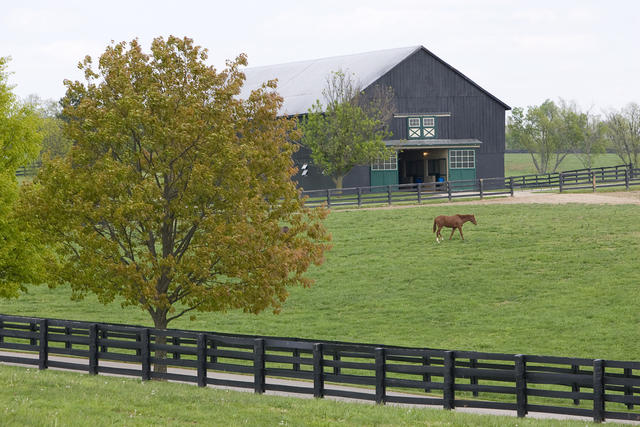More than a pretty face; study shows agriculture’s impact on Woodford’s economy
More than a pretty face; study shows agriculture’s impact on Woodford’s economy

Very few would dispute the beauty of Kentucky farmland in the lushness of spring. But a study by the University of Kentucky’s Community and Economic Development Initiative of Kentucky shows that agriculture is more than just a pretty face. In Woodford County, agriculture and the businesses that support it are responsible for one out of three jobs and $565 million in annual revenue.
The CEDIK study was unveiled at a recent news conference at the UK College of Agriculture, Food and Environment’s C. Oran Little Research Center in Woodford County. The study examines the influence of the agricultural cluster to Woodford County’s economy.
“As a college, we are proud to assist counties in characterizing the value of agriculture and equine enterprises on economic development,” said Dean Nancy Cox. “This research takes a lot of time and effort, and the methods used by CEDIK produce unique and sound insights.”
Traditionally, employment associated with agriculture has been confined solely to production. The study’s authors expanded that view to include not only production agriculture, but businesses that produce agricultural inputs, wholesale and retail businesses and service-based businesses that are dedicated to agriculture, such as veterinary, finance, recreation and transportation. Authors Alison Davis, Simona Balazs, Joe Kercsmar and Melody Nall assert that including these types of businesses shows the true importance of the agricultural sector in the area.
“We often focus on more traditional industry as representing a predominantly large share of employment, so the tendency is to focus on manufacturing, health care and education. But in these counties like Woodford County, agriculture and the equine industry are equally as important to their local economy,” said Davis, UK agricultural economist and executive director of CEDIK. “We drive by and see these pretty farms and think, this is a beautiful place to live, but they are also significant contributors to the local economy.”
When the agricultural cluster is defined to include companies with some or all of their business related to agriculture in the county, it is estimated that 2,783 jobs are attributed to the cluster. Without an agricultural base in the county, many of those businesses would not exist.
“Woodford County has a relatively small employment base; there are just under 10,000 full-time employees in the county,” Davis said. “One of every five jobs is directly attributable to agriculture and its supporting services, and if you widen that to include the multiplier effect of the agricultural cluster, then it’s one out of three. That’s a pretty significant market share for a county the size of Woodford.”
In Woodford County, agricultural production is among the top five industries, with manufacturing leading in the number of jobs. Government, educational services and retail trade round out the top five. Woodford County has a higher concentration of employment in animal and crop production than the national average. The higher the concentration, the more likely support industries will be present in the area.
In addition, it is estimated that the ag cluster contributes $1.1 million to the local tax base through payroll taxes. Approximately 14 percent of total properties in the county are farms, which generate $5.2 million in property taxes—25 percent of the total tax base.
In addition to the $565 million in annual revenue, the researchers found that the county’s agricultural cluster generated more than $340 million in additional income, profits and dividends.
One of the unique aspects the study examined were stud fees for the Thoroughbred industry in Woodford County. The county is home to 11 of the top 20 Thoroughbreds covering mares in the country. The sales tax imposed on those services gets turned around into breeders’ incentive funds.
“While the stud fees that are posted aren’t necessarily the final prices that are negotiated, it’s still a really significant source of revenue and sales tax revenue,” Davis said.
Because of the increasing pressures on land use, the researchers looked at the effect of a loss in production agriculture. They found that if production agriculture declined by 10 percent or $26.8 million, there will be an overall additional decrease of more than $8.4 million in output. Part of that loss would come from approximately $2.4 million reduction in sales from business spending. Businesses involved in food products, truck transportation, warehousing, veterinary services and wholesale trade, just to name a few, would be most affected by a reduction in production agriculture in the county. The loss suffered by industries as a result of a reduction in household spending, what’s known as the induced effect, would be even greater, approximately $6 million.
“The ag industry is not necessarily the most important industry, it’s not the largest industry, but it’s important for these communities—particularly small communities—to have a diverse portfolio of economic development strategies and industries. This study illustrates that in Woodford County, it’s an important part of the economy, and it should be an important part of the discussion with economic development professionals, educators and planners in the county.” Davis said.
Sponsors of the study include Kentucky Performance Products, Kentucky Thoroughbred Owners and Breeders Inc., Pisgah Community Historic Association and Woodford Forward. The full study can be found online at https://cedik.ca.uky.edu/sites/cedik.ca.uky.edu/files/final_woodford_forward_report_april_23.pdf.
Community Development Economics Research


